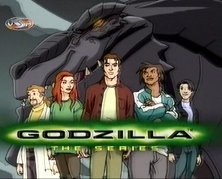
Episodes 1 & 2 – A New Family
It may not be the most popular or most famous cartoon series of the 1990s and it’s far, far from the best. But even the die hard haters of Roland Emmerich’s 1998 Godzilla film admit a small place in their hearts for this cartoon series. They had no faith going in, allowing the series to pleasantly surprise them…even as it annoyed and frustrated.
Like Justice League after it, Godzilla: The Series successfully mined every useful idea out of it’s parent genre, eventually managing to distill at least fifty years of daikaiju movies into their purest, most ridiculous essence…and I mean that as a compliment. Because if you’re into this sort of thing you really couldn’t ask for more. What we have here, for example, is a animated, one hour, made-for-TV daikaiju movie. From America. Name another one of those from the last ten years. Go on. I’m so desperate for human communication I’m actually daring you to name one. Go on. But read this first.
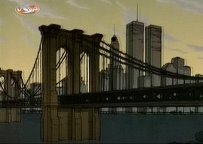
Obviously, I love this series, from its unrepentantly stupid premise to its unfulfilled, abrupt conclusion. It presented unrepentant junkies (like your humble narrator) with our weekly giant monster fix. The pilot episode serves this up right from frame one, and because this began life as a half-hour Saturday morning cartoon, restrictions of time and budget ensure even the worst episodes have a breakneck pace.
Unlike Dean Devlin and Roland Emmerich, it’s obviously the producers of this show knew exactly what they were doing and who they were doing it for. While maintaining continuity of characters and relationships with the much-derided movie, The Series succeeded where it failed by gradually expanded its mythology. Sooner or later, they got around to everything in this show. And I’m going to have a damn good time pointing everything out. So let’s get right to that Pilot.
After a low-budget recap of Godzilla The Movie’s final moments, we catch up to the movie’s main character – biologist Nick “Worm Guy” Tatopoulos (now voice by Ian Ziering) – as he and Major (nee, Colonel) Hicks (Kevin Dunn, reprising his role from the movie) set out into the unstable warren of Godzilla-created tunnels that used to be Manhattan’s subway system.
Our Scientist and our Military Commander are hunting down Godzilla eggs since, as we all know, that Godzilla we just saw die a Brooklyn-Bridge-destroying death was an asexual parthenogenetic. A well-timed cave-in separates Dr. Nick from his military minders, sending him, like Alice, down a hole and into a strange new, topsy-turvy lifestyle, the poor bastard. Nick lands in a small puddle of orange-yellow goo not five feet away from the object of his search: the last remaining Godzilla egg, miraculously intact after the aerial bombardment of Madison Square Garden.
The egg hatches right on cue. Its issue—a bobble-headed, spindle-limbed version of “his” progenitor—sniffs at Nick, licks his face, and retreats when the spark of a broken high-voltage line stuns its widdle, newborn eyes. Major Hicks is nonplussed at Nick’s news of the newborn and basically fires him for plot-related reasons. “Now it’s time for the hunters to hunt,” he says, “and the lab rats to go back to the lab.”
Frustrated, Nick recruits fellow Drs. Elsie Chapman (Charity James) and Mendel Craven (Malcolm Danare) from Hicks’ forward base for a little freelance monster hunting. You probably don’t remember Elsie and Craven but trust me: they are actually present in Emmerich’s film. Malcolm Danare joins Kevin Dunn in the reprise parade, while Charity James provides a more-cynical and less-sultry take on Dr. Chapman’s character than her live action counterpart, Vicki Lewis. It’s interesting to see the movie’s bit-part characters (who functioned more or less as nay-saying co-Scientists, there to shoot down Matthew Broderick’s script-induced feats of deduction and insight) become core members of the Series cast. Makes me wonder how the movie might’ve played out if it’d ignored Dr. Nick’s unhealthy, co-dependent love life and instead focused on the interplay between the three Scientists.
“We’re the only ones who can track it,” Nick says here. “You wanna help me see this thing through, or would you rather wait for the army to screw it up?” Joined by Nick’s “research assistant” (re: Odious Comic Relief) Randy Hernandez (Rino Romano—another American voice actor who should be more famious than he is, who’s since gone on to play everyone from Spider-Man to Bruce Wayne to the Narrator of Curious George), Our Heroes turn Nicks’ “research facility” (re: converted warehouse) on Staten Island into a “staging area” for their monster hunt. As in the film, conventional military forces are obviously unprepared for such things and incompetent to the point of criminal negligence. You go to all the trouble of getting the one biologist on Earth (that we’ve seen so far) who specializes in radiation-induced mutations onto your team…and then you just cut him loose now that you think the job’s “over”? More fool you, Col. Maj. Hicks: it’s never over!
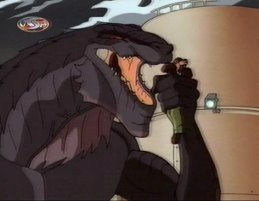
Expecting a human-sized monster, it’s not long before Dr. Nick’s intrepid little band receives its first surprise: a T-Rex-sized Godzilla who comes bounding out of the bay and makes scrap-metal of their improvised cage. Making a b-line for Dr. Nick, Godzilla stops short of popping Our Hero into his mouth. Instead, the visibly-calmed monster gives Dr. Nick a friendly-puppy lick, sets him down, and waits patiently for…what?
With three PHDs between them, Our Heroes quickly deduce that Godzilla’s imprinted on Dr. Nick…and strange as it sounds, this actually makes some kind of sense. “I had this gunk from the eggs all over me,” Nick remembers. Yeah, Doc…that’d be a little thing called “afterbirth.” Something you, as a biologist, could’ve guessed at the time. But I supposed we can’t say icky things like that on Saturday morning cartoons from the late-90s.
In true Movie Scientist fashion, Nick decides to study Godzilla rather than kill the lizard now. Convincing his colleagues to go along with this proves far too easy, but we’re quickly running out the clock here, so…c’es la vive.
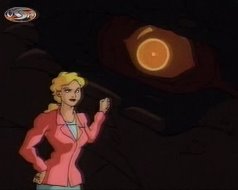
Too bad Nick makes no move to tell his erstwhile girlfriend, WIDF reporter and most-hated-character of the The Movie Audrey Timmonds (now played by Paget Brewster…thank God), about his most recent discovery. This leaves Audrey and cameraman Victor “Animal” Polotti (now Joe Pantoliano since Hank Azaria already had a voice-actor gig at the time) to accidently come across Godzilla curled up on Nick’s doorstep. Nick and Audrey set the tone of their relationship by arguing across Godzilla’s flank for awhile, prompting a very adverse reaction when Audrey raises her voice to Nick. Here the army descends to bomb Godzilla back into the bay and break up this bit of domestic bliss.
With Our Monster seemingly destroyed and Our Heroes (and Audrey and Animal) under temporary house arrest, Nick grows suspicious. He accuses Audrey of snitchin’. Audrey denies this and accuses Elsie, who snipes back. Nick and I take a moment to wonder why every woman in his life is a psychological twelve-year-old.
Hicks and Nick decide to take the air on Nick’s balcony, the Twin Towers of the World Trade Center all-too-prominent behind them. The Scientist and the Military Commander have a small debate on the ethics of live giant monster research, call it a draw (since, if Godzilla’s dead again, the issue’s moot) and depart as friends. Nick even avoids the first of what will surely be many treason charges and stints in Guantanamo Bay by the good graces of Maj. Hicks.
That night (the Twin Towers still visible, by God) Elsie and Craven depart for Jamaica, where ships and swimmers have recently developed a bad habit of vanishing. Nick and Odious Comic Relief (I’m sorry—his name’s Randy) stay behind to discover Monique Dupree (Gargoyles and Red Shoe Diaries regular Brigitte Bako) breaking into the house computer. A Special Agent from Direction Generale de la Securite Exterieure, Monique presents herself to Dr. Nick as a team weapons master, bodyguard and (un)official liaison with Jean Reno, who won’t be appearing in this series…yet.
“Don’t know ‘bout you, jefe,” Randy the human goliwog comments, ”but I feel safer already.” Nick takes Monique’s offer up grudgingly, since she was the one who called the military down on their little Godzilla Party. But we’ve no time for character conflict now! We’re off to Jamaica to fight monsters, damnit.
Elsie and Craven, meanwhile, have run into some giant squid and gotten themselves cocooned in the electrolyte-sucking tar those squids use to predigest. Nick, Randy and Monique rescue them, drawing the squid’s ire. It’s never mentioned in the episode, but it’s fun to speculate about this whole sequence’s relationship to that little Jamaican excursion the cast took early on in The Film. Where these squid stirred up by Godzilla Mark I’s marathon swim past the island? Before or after Godzilla Mark I beached that cannery ship? If after, why has it taken the squid so long to attract notice (particularly if they’re snatching swimmers out of the shallows)? If before, why did Godzilla go after the ship at all, when miles of delightful-looking, unarmored calamari were right out in the open?
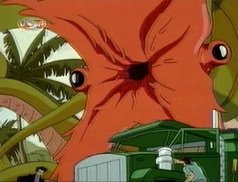
Never mind. Godzilla Mark II – grown to his full Toho-height in a matter of days (don’t ask me how) – returns from the dead just in time to rescue Nick and Co. from the Squid Brigade. Nick projects loyalty on Godzilla’s actions, but the implications of this are ignored…if for no other reason than the appearance of Crustaceous Rex.
This, first of Godzilla’s reoccurring foes, sets the tone for the remainder of the series with its striking visual design and complete biological impossibility. (Legs and tentacles? Somebody got fucking greedy.) A well-animated monster attack/chase scene/fight ensues, carrying Nick and Co. across a good chunk of Jamaican coast. Maj. Hicks and U.S. military arrive at the last minute, of course, but it’s okay. After violating all kinds of territorial sovereignty, the military just stands around while Godzilla does their job for them. (Pretty smart move, actually.)
After triumphing over C-Rex, the Big G moves on to prove his superhero credentials by dredging the bay, using that tried and true Superfriends tactic of swimming around in a circle real fast. The resulting vortex floats all those tar-encrusted missing persons (and boats) up to the surface.
Hicks still attempts to call an air strike down, but Dr. Nick trumps this by arguing that Godzilla is “the only thing that stands between us and every other mutation that comes out of the woodwork. And believe me, Major, there will be others.” With a reluctance totally within character (and an authority out of all proportion to his rank) Maj. Hicks agrees to spare Godzilla’s life, and the Big G returns to the seas.
Like any good Pilot, New Family shows the first shoots of what this series would grow into. Stripped of its connections to The Movie, this cartoon becomes a classic daikaiju rumble: The Monster as Friend to Man vs. the Monster From the Deep, set against the tropical backdrop of Jamaica, recalling Jun Fukuda’s Godzilla movies. While Nick’s relationship with Godzilla approaches Gamera territory (making Dr. Nick potentially the World’s Oldest Kenny), I’m willing to let it slide since their “bond” really is the dramatic axis of the show, keeping Our (Human) Heroes involved in a way most giant monster film-protagonists never will be…so long as directors think it’s okay for characters to finish up a story blithely watching the monsters fight from Minimum Safe Distance.
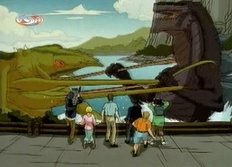
If anything, Dr. Nick and his followers are more proactive than Godzilla himself. Our Heroes showcase an ad-hoc, improvisation style of giant monster fighting that’s inventive by necessity. They never pull the same trick twice and they certainly don’t sit around with their thumbs up their asses waiting for the military’s next superweapon to roll off the assembly line. Their Japanese contemporaries in the Heisei Godzilla films – G-Force – could learn a thing or two from this bunch of TV scientists.
More’s the pity their series suffers from all the idiotic constraints of American “children’s” television, including but not limited to a relatively low budget (see below) and a general squeamishness in regards to death that’s really starting to show its age.
Godzilla as a whole hasn’t aged well. Computer technology was in its infancy at the time and the uneven quality of animation testifying to this, lending the whole works one more layer of unbelievability than it needs. With my suspension of disbelief already stretched to the limit, I don’t want persnickety issues of scale distracting me…but good Lord, sometimes Godzilla and his monster rivals look tall as the Rockies…sometimes, not. Sometimes fight scenes become less like action sequences and more like surrealist interpretations of such. Witness Godzilla vs. C-Rex. The “G-man’s” anatomical dimensions have all the stability of a Salvador Dali watch. It’s annoying and ever-present. If you want to enjoy this show, you’ve just got to learn to live with it. Should be no problem for men and women raised on rubber suits from the 1970s…but you’ll be laughed at mightily for giggling over these little daikaiju nuggets.
So fuck the uninitiated. They don’t know what they’re missing. For one thing, it’s obvious this series takes place in a fantastic parallel dimension where giant monsters just appear, popping into existence like Mother Earth’s own acid flashbacks. The possibilities of such a place immediately fires that part of my brain that reads hard science fiction. Who knows what the governments of the world are planning now that a giant monster’s tried to turn New York City into its rookery? Is the U.S. about to declare a worldwide War on Monsters?
And why, exactly, is the CIA allowing some jumped-up French agent to attach herself to Dr. Nick Tatopoulos, Savior of New York City and the Man Who Destroyed Godzilla (well…the first one, anyway)? Where’s the FBI on this? Or the NSA? Or the Pentagon? Where’s anybody? Where’s the new, Cabinet-level post created specifically to deal with the “imminent threat” of giant monster attacks? Where’s the new Executive Department designed to funnel money to Congressional and Presidential cronies under the guise of “keeping America safe”? Where are the speeches, the debates, the political pomp and circumstance? Where is this show when we really need it, to help explore the fractured, fucked-up character of the early twenty-first century?

I overhead someone at a bus stop the other day, wondering about the pre-9/11 world. She was in fifth grade on That Day, and really has no memory of the Time Before, which is just fucking sad. Well, little girl, watch this cartoon and stare in slack-jawed wonder at the naiveté of that time…
The main character’s overlapping love triangles (Nick likes Audrey, Elsie likes Nick [or she just likes to piss Audrey off—and more power to you, Red], Mendel likes Elsie; Randy, true to his name, has an instant crush on Monique, for which I do not blame him) are annoying, but not disastrously so…yet. There’s just too much for everyone to do. Even Godzilla receives the dignity due him, Dr. Nick licking notwithstanding. Unlike previous Godzilla Series, there’s no Scrappy here, and the monsters are always played up as genuine threats…no matter how silly doing so might seem.
The human characters always supply the Odious faux-comedy…and all I can really say about them here is, “Learn to love playful splashing.” There are more wet T-shirts on Nick’s team than in the titty bars down the street from my Batcave. No wonder all the characters seem to brim over with displaced aggression—they’re all horny teenagers, trapped in adult bodies and further ensnared by the constraints of the Fox Kids Standards and Practices.
I’ll derail that little train of thought right now before it escapes my control, and meet you again in the next episode: Talkin’ Trash.

Ah yes. The existence of this series is the best thing that came out of that movie. It still wasn’t the American Godzilla I would have wanted but it was giant monsters fighting giant monsters every Saturday morning. That worked for me.
That’s more than a general consensus: it’s damn near universal. That’s part of why I’m doing this. I want to discover why it works, what made the workable bits work so well, and why those bits occasionally didn’t work, and occasionally failed spectacularly. It’ll be a grand research project, because I was one of those kids who liked taking things apart so I could put them back together again in new and interesting shapes.
I think you’ve pointed to part of what works already. Our human heroes actually have a role in the fight. They’re not just time filler until Godzilla kicks this week’s Guestzilla’s ass.
Add a variety of international locations and interesting monsters to the mix (creatures that wouldn’t have worked nearly as well with suitmation) and you’re ahead of the game.
Here’s what gets me: you’d think giving humans a stake in the ongoing War Against Monsters would be the easiest thing in the world, but as plots have resolved themselves into formulas, the already-stock characters of the genre seem to have lost what little personality they possessed in the 50s and 60s. Sure, it was a crazy time – what with the thrice-weekly invasions from alien armadas and/or sunken, undersea kingdoms – but it was also a time of authentic heroes. Like astronauts Glenn and Fuji from Monster Zero. Or Goro Ibuki, the inventor of Jet Jaguar, and thus the Tony Stark of his age. Good characters, who stood out by virtue of being characters, rather than empty shells the audience could more-easily pour themselves into….assuming we’d even want to be Miki Saegusa in the first place. No matter how many times I watch those films I can’t name one authentically good character from Heisei series. Even Darling Miki only stands out by virtue of being psychic, i.e., mostly useless. As opposed to everyone else, who end up being totally useless more often than not…unless there’s a time machine around.